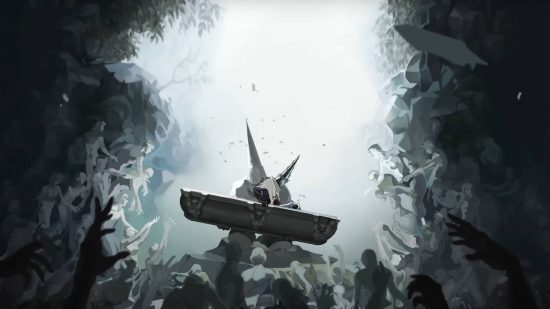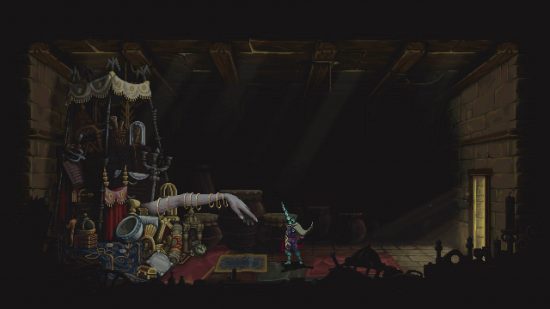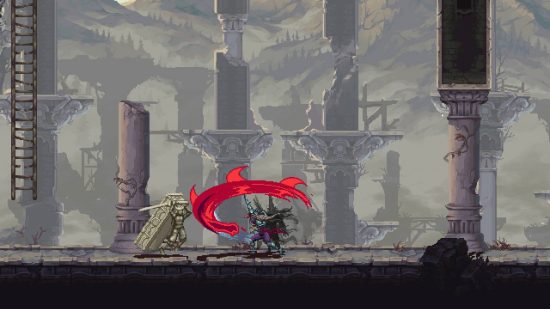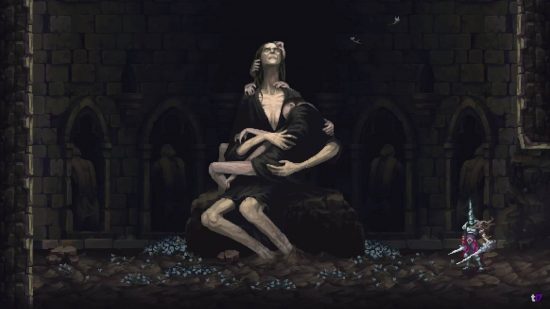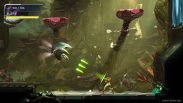If I need to describe the Blasphemous franchise, I’d say it’s “meticulously macabre.” The journey of the cone-helmeted Penitent One through the nightmare realm of Cvstodia amazes me with its painstakingly precise pixel art. From complicated architecture dripping in religious imagery to the terrifying cast of demons and creatures aching to tear you limb from limb in every single area.
Now, after the success of the original, developer The Game Kitchen and publisher Team 17 decided to fly out to the studio’s home of Seville to get our hands on Blasphemous II, surrounded by the very religious architecture that inspires so much of both titles.
Like many, I struggle with the opening hours of Blasphemous, but persistence pays off, as buried deep under a demanding and deliberate combat system is a rewarding action game that features a world full of horrifying secrets well worth your time to uncover. But now, The Game Kitchen is taking everything that works about the original and making a sequel that’s even more Blasphemous, in the best possible way.
Blasphemous II picks up some time after the end of the original’s Wounds of Eventide DLC, and once again, the Penitent One wakes up in a strange land plagued with evil and is on a mission to uncover the mysteries of ‘The Miracle’. Neither the setting nor the combat are a drastic departure from the original, but instead subtle evolutions with a richer pool of inspirations this time around.
To begin with, The Penitent One gets to choose from three different weapons in the early stages of the game. A large spiked ball, a long sword, and two daggers. You get ample time to play with each before you make your choice, and it’s clear that the game wants you to play exactly how you want to. For my session, I couldn’t help but go with the spiked ball, though I really enjoy both of the other weapons as well.
The spiked ball (I’m sure it has a fancier name, but I forgot to make a note of it) moves with heft and consequence, though it takes several frames to build up your attack it does unleash a devastating swing. You can also charge it for a more powerful attack, but you must choose your moments wisely, as your enemies have neither patience nor mercy.
Just moments into the start of the game is a boss that combines acrobatic diagonal attacks with a spinning wheel covered in spikes. It’s a strong opening and a fight with heavily telegraphed attacks, communicating Blasphemous II’s combat well. You immediately know you have to pay attention, but Blasphemous II rewards that dedication. It’s also worth mentioning that Blasphemous II runs at a silky smooth 60fps – even on Switch – and that adds to the fantastic feel of combat and movement.
With several smart changes, it feels like Blasphemous II developer The Game Kitchen wants to expand upon what works so well about the original. The choice of three weapons is a great start, and each has its own particular style that already feels deeper than the original’s single sword. There’s also a skill tree with additional moves, and I cannot wait to earn more of the Penitent One’s more gruesome actions later on.
Another striking change comes in traversal. The Game Kitchen is keen to improve upon the platforming of the original, as it’s still one of the biggest complaints among fans. While the first title’s combat is slow and deliberate defensive style works for a Dark Souls-inspired 2D game, the accompanying movement does drag down exploration.
However, while in Blasphemous II, the Penitent One still feels weighty, and actions have satisfying consequences, here the protagonist feels more agile. The change seems to be a mixture of new moves found as you explore, as well as the quicker attacks on each weapon, but Blasphemous II definitely feels like a much better balance of satisfying action and quick exploration.
It’s not quite the lightning-quick speed of an Ori game, but every action feels more exciting to command. Plus, there are secrets and collectibles in every possible inch of the world. I hope backtracking and abilities don’t bog down the sequel too much, but it seems that the first weapon you choose informs how you interact with the world, and as you find the remaining two, you unlock more ways to fight and move.
So, the game feels amazing, and I feel strongly that fans of the original will love the improvements made. But once again, the star of the show is the world you explore. Speaking to Blasphemous II’s lead level designer Enrique Colinet, he reveals the world of Blasphemous II isn’t quite as large as the eventual size of the first Blasphemous with its many subsequent DLC additions. However, it is larger than the launch map of the original Blasphemous.
The graphics maintain that stunningly detailed pixel art and dour horror influence, but the actual design feels slightly brighter and more legible. The world of Blasphemous II uses splashes of color to accentuate both the architecture and monsters, but also to better demonstrate the visual design of the levels. Which is great, because you want to explore every inch of this incredible world.
Clearly, the original pulls passionately and generously from religious architecture and horror paintings, and speaking to concept artist Juan Miguel López Barea reveals the sequel has a bigger focus on the more gruesome works of artists such as Francisco Goya. It’s evident even in Blasphemous II’s early moments, as certain discoveries reveal huge and stunningly realized painterly pixel art scenes, incredibly well adapted from the beautifully gruesome art of the team.
The team also mentions pulling from a wider range of Spanish influences, such as flamenco. We didn’t see much in our brief time, but we look forward to discovering new areas and their visual design. In a Q&A, composer Carlos Viola even describes using a wider range of instruments for the score, all adding to the ethos of Blasphemous II having “a richer feel with higher quality.”
I certainly hope Blasphemous II keeps up the pace and quality of its opening moments, but I’m filled with confidence both from the enthusiasm and will to improve that the team displays, and also the incredible impression those first steps display. Blasphemous II feels like a smarter and faster game, but its world still demands you play by its rules. The Penitent One has his work cut out for him, but now he feels more capable than ever before.

Blasphemous II feels much more like a Metroidvania, with a world begging for you to explore it. Plus, while there are some improvements to combat, I think the changes to its speed, as well as the adjustments to traversal, mean that every moment of gameplay feels much more exhilarating to pull off. I’m not sure there’s enough here to convince people who didn’t enjoy the original, but eager fans are going to absolutely adore the improvements and expansions the sequel presents.
If this has got you in the mood for more platforming adventures, be sure to check out our guide to the best Switch Metroidvanias.
